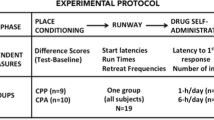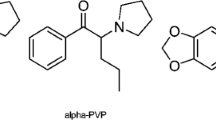Abstract
Dose-dependent differences in the rewarding and stimulant properties of cocaine administered intravenously (IV) and intraperitoneally (IP) were compared. Six 2-day conditioning trials were conducted over consecutive days. Rats received cocaine and were placed into a compartment on one day of the trial, and were directly placed into a different compartment without drug on the other day. Rats were exposed to the compartments for either 20 or 40 min. The effects of cocaine on stimulant behaviors, including locomotion and stereotypies, were compared following the first and last injection. After conditioning, three tests were given with 1 rest day intervening each: (1) conditioned place preference (CPP) was measured as an increase in the amount of time animals spent in the injection compartment relative to the noninjection compartment when given access to both, (2) conditioned activity (CA) was measured as an increase in stimulant behaviors in cocaine-treated animals relative to saline controls following an injection of saline in the injection compartment and (3) context-independent sensitization was measured as an increase in stimulant behaviors following an injection of cocaine in the noninjection compartment relative to the animals' behavior following the first injection. Cocaine did not reliably produce sensitization of locomotion under any of the conditions examined. Cocaine produced sensitization of headbobbing that was more robust following IP administration than it was following IV administration. In both cases, sensitization of headbobbing involved a context-independent component. Cocaine produced CPP and CA with both routes of administration. CPP was established more readily with 40-min relative to 20-min exposures following IV administration, whereas CA was more prevalent with 20-min relative to 40-min exposures. This study provides a thorough characterization of the behavioral effects of cocaine administered IV and a new efficient method for assessing the effects of cocaine on conditioned and unconditioned behaviors following repeated administration.
Similar content being viewed by others
References
Bardo MT, Neisewander JL, Miller JS (1986) Repeated testing attenuates conditioned place preference with cocaine. Psychopharmacology 89:239–243
Bardo MT, Rowlett JK, Harris MJ (1995) conditioned place preference using opiate and stimulant drugs: a meta-analysis. Neurosci Biobehav Rev 19 [1]:39–51
Barr BA, Sharpless NS, Cooper S, Schiff SR, Paredes W, Bridger WH (1983) Classical conditioning, decay and extinction of cocaine-induced hyperactivity and stereotypy. Life Sci 33:1341–1351
Beninger RJ, Herz RS (1986) Pimozide blocks establishment but not expression of cocaine- produced environment-specific conditioning. Life Sci 38:1425–1431
Broderick PA (1992) Distinguishing effects of cocaine IV and SC on mesoaccumbens dopamine and serotonin release with chloral hydrate anesthesia. Pharmacol Biochem Behav 43:929–937
Downs AW, Eddy NB (1932) The effect of repeated doses of cocaine on the rat. J Pharmacol Exp Ther 46:199
Ellinwood EH, Kilbey MM (1980) Fundamental mechanisms underlying altered behavior following chronic administration of psychomotor stimulants. Biol Psychiatry 15:749–757
Hinson R, Poulos C (1981) Sensitization to the behavioral effects of cocaine: modification by pavlovian conditioning. Pharmacol Biochem Behav 15:559–562
Hooks MS, Jones GH, Smith AD, Neill DB, Justice JB (1990) Individual differences in locomotor activity and sensitization. Pharmacol Biochem Behav 38:467–470
Kalivas PW, Duffy P, DuMars LA, Skinner C (1988) Behavioral and neurochemical effects of acute and daily cocaine administration in rats. J Pharmacol Exp Ther 245:485–492
Kilbey MM, Ellinwood EH (1977) Reverse tolerance to stimulant-induced abnormal behavior. Life Sci 20:1063–1076
Kiyatkin EA (1992) State-dependent peculiarities of cocaine-induced behavioral sensitization and their possible reasons. Int J Neurosci 67:93–103
Lau CE, Imam A, Ma F, Falk JA (1991) Acute effects of cocaine on spontaneous and discriminative motor functions: relation to route of administration and pharmacokinetics. J Pharmacol Exp Ther 257:444–456
Lett BT (1989) Repeated exposures intensify rather than diminish the rewarding effects of amphetamine, morphine, and cocaine. Psychopharmacology 98:357–362
Lin-Chu G, Robinson TE, Becker JB (1985) Sensitization of rotational behavior produced by a single exposure to cocaine. Pharmacol Biochem Behav 22:901–903
Mayer LA, Parker LA (1993) Rewarding and aversive properties of IP and SC cocaine: assessment by place and taste conditioning. Psychopharmacology 112:189–194
McKim WA (1991) Drugs and behavior: an introduction to behavioral pharmacology, 2nd edn. Prentice-Hall, Englewood Cliffs, New Jersey
Mucha RF, Van der Kooy D, O'Shaughnessy M, Bucenieks P (1982) Drug reinforcement studied by the use of place conditioning in rat. Brain Res 243:91–105
Nomikos GG, Spyraki C (1988) Cocaine-induced place conditioning: importance of route of administration and other procedural variables. Psychopharmacology 94:119–125
Orona RA, Mayfield RD, Cline EJ, Zahniser NR (1994) Repeated intravenous cocaine administration to rats produces behavioral sensitization without changing brain cocaine levels. Neurosci Lett 167:121–124
Petry N, Furmidge L, Tong Z, Martin C, Clark D (1992) Time sampling observation procedure for studying drug effects: interaction betweend-amphetamine and selective dopamine receptor antagonists in the rat. Pharmacol Biochem Behav 44:167–180
Porrino LJ (1993) Functional consequences of acute cocaine treatment depend on route of administration. Psychopharmacology 112:343–351
Post RM, Rose H (1976) Increasing effects of repetitive cocaine administration in the rat. Nature 260:731–732
Post RM, Lockfield A, Squillace KM, Contel NR (1981) Drug-environment interaction: context dependency of cocaine-induced behavioral sensitization. Life Sci 28:755
Post RM, Weiss SRB, Pert A (1987) The role of context and conditioning in behavioral sensitization to cocaine. Pshchopharmacol Bull 23:425
Post RM, Weiss SRB, Fontana D, Pert A (1992) Conditioned sensitization to the psychomotor stimulant cocaine. Ann NY Acad Sci 654:386–399
Resnick RB, Kestenbaum RS, Shwartz LK (1977) Acute systemic effects of cocaine in man: a controlled study by intranasal and intravenous routes. Science 195:696–698
Roy SN, Bhattacharyya AK, Pradhan S, Pradhan SN (1978) Behavioral and neurochemical effects of repeated administration of cocaine in rats. Psychopharmacology 17:559–564
Shippenberg TS, Heidbreder C (1994, June) k-Opioid receptor agonists prevent sensitization to the rewarding effects of cocaine. Paper presented at the College on Problems of Drug Dependence annual meeting, Palm Beach, Fla.
Spyraki C, Fibiger HC, Phillips AG (1982) Cocaine-induced place preference conditioning: lack of effects of neuroleptics and 6-hydroxydopamine lesions. Brain Res 253:195–203
Spyraki C, Nomikos G, Varonos DD (1987) Intravenous cocaine-induced place preference: attenuation by haloperidol. Behav Brain Res 26:57–62
Tella SR (1994) Differential blockade of chronic versus acute effects of intravenous cocaine by dopamine receptor antagonists. Pharmacol Biochem Behav 48:151–159
Weeks JR (1962) Experimental morphine addiction: method for automatic intravenous injection in unrestrained rats. Science 138:143–144
Weiss SRB, Post RM, Pert A, Woodward R, Murman D (1989) Context-dependent cocaine sensitization: differential effect of haloperidol on development versus expression. Pharmacol Biochem Behav 34:655–661
Yeh SY, Haertzen C (1991) Cocaine-induced locomotor activity in rats. Pharmacol Biochem Behav 39:723–727
Zahniser NR, Peris J (1991) Neurochemical mechanisms of cocaine-induced sensitization. In: Lakoski JM, Galloway MP, White FJ (eds) Cocaine: pharmacology, physiology and clinical strategies. CRC Press, Boca Raton, pp 1–52
Author information
Authors and Affiliations
Rights and permissions
About this article
Cite this article
O'Dell, L.E., Khroyan, T.V. & Neisewander, J.L. Dose-dependent characterization of the rewarding and stimulant properties of cocaine following intraperitoneal and intravenous administration in rats. Psychopharmacology 123, 144–153 (1996). https://doi.org/10.1007/BF02246171
Received:
Revised:
Issue Date:
DOI: https://doi.org/10.1007/BF02246171




